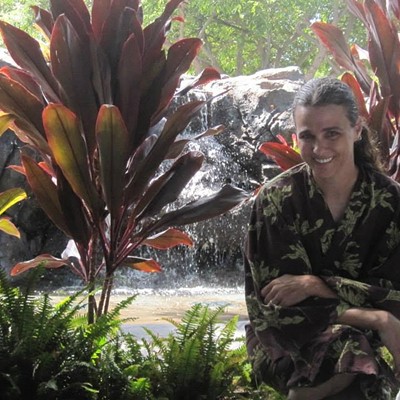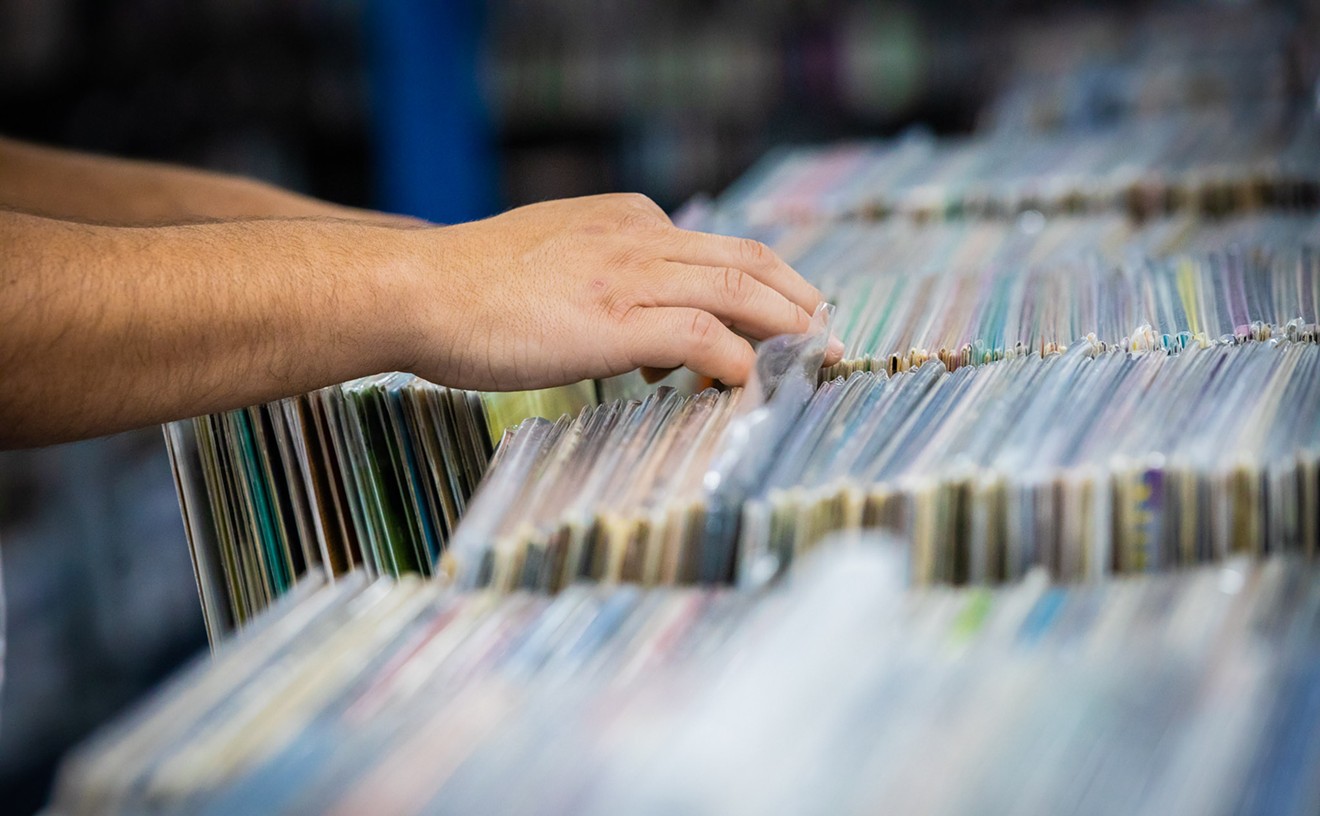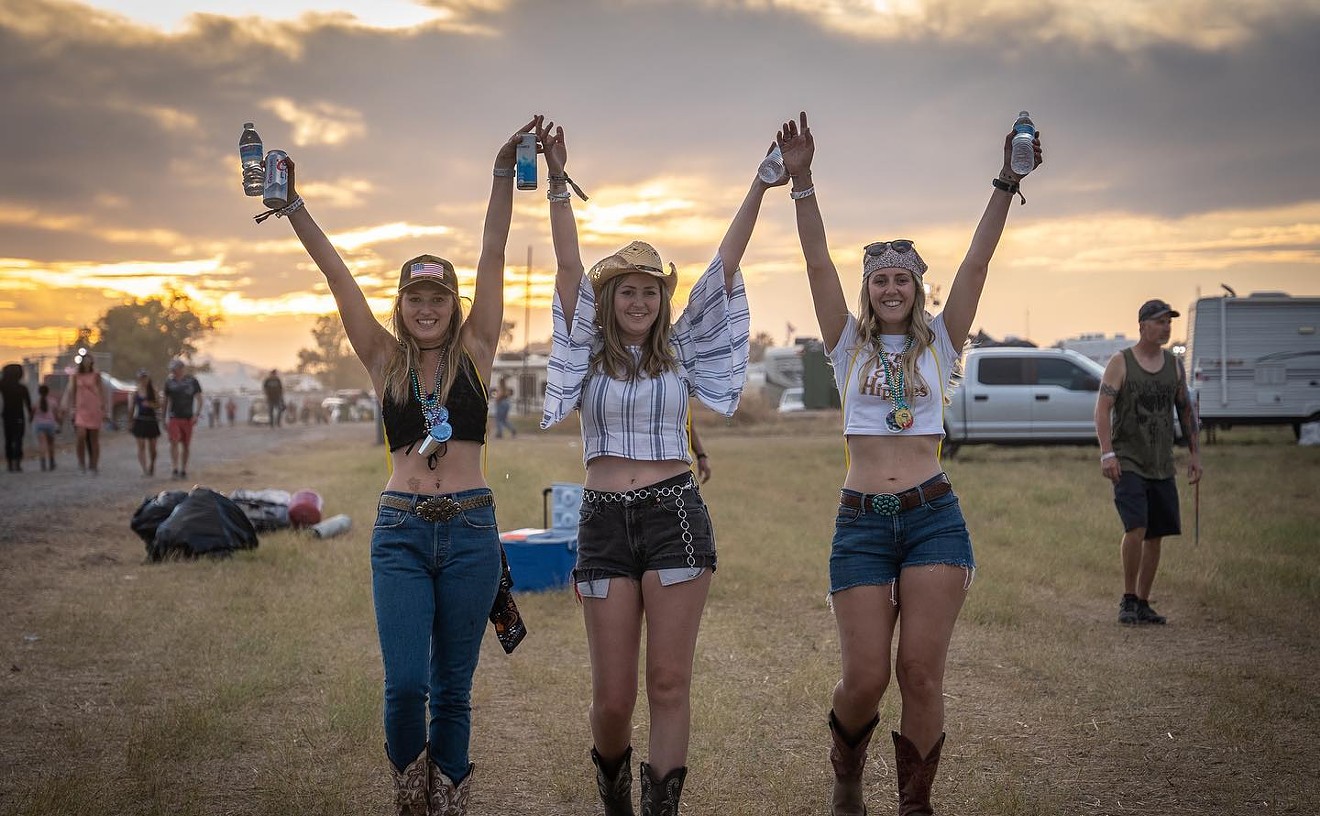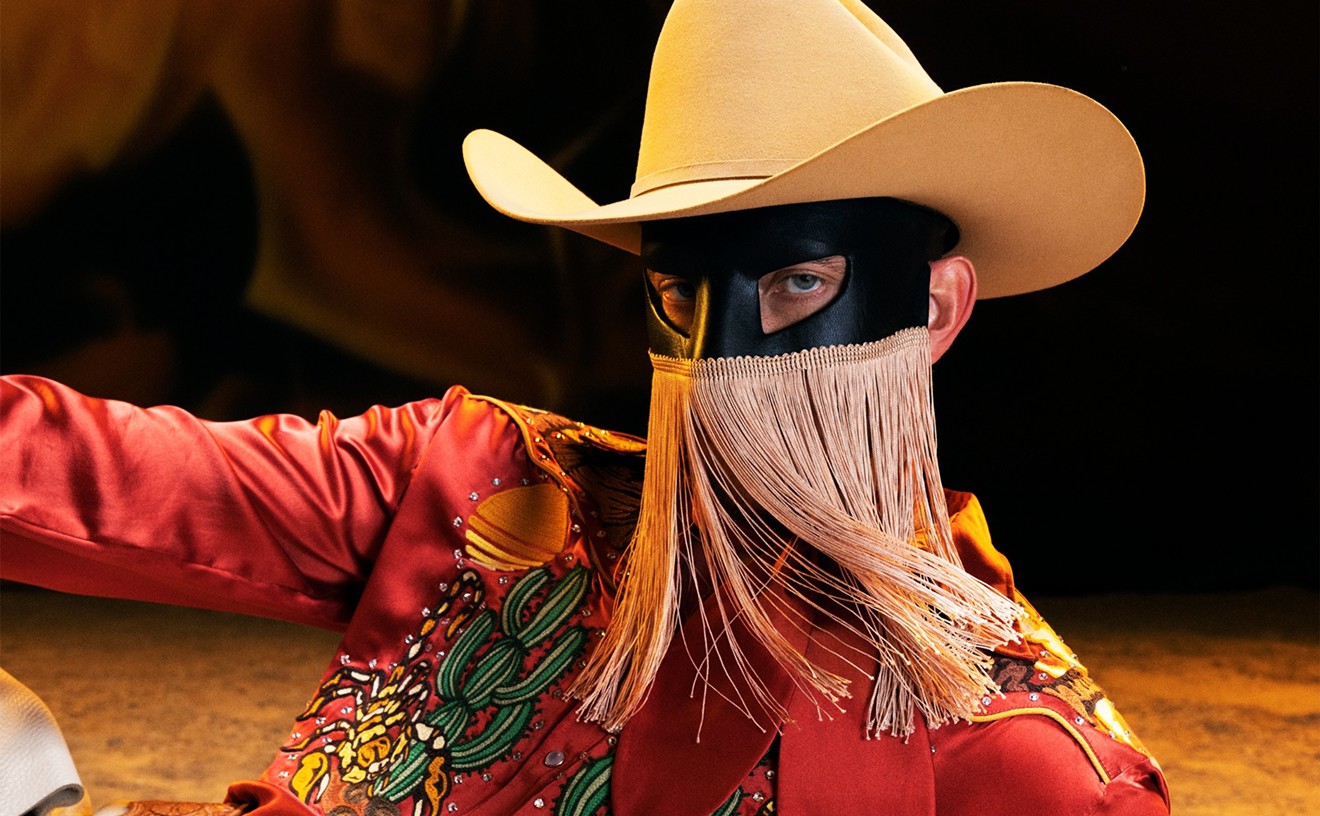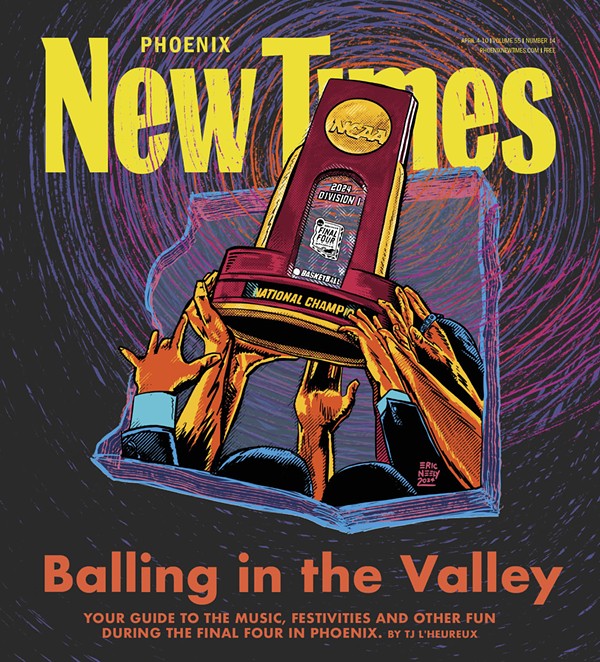The club manager gets onstage, beneath the blue neon glow of a Budweiser sign. "Kill the jukebox," she says. "It's so cool to have this band here. Marco Polo was, like, the first rockabilly guy in Phoenix, since, like, the '80s. Please welcome Curse of the Pink Hearse!"
Behind her, Marco Polo smiles. He's wearing sunglasses and gripping an upright bass that's almost as big as he is. It's painted to look like a spotted cow. When the band starts to play, Polo assails his bass with fast finger work and half-sings, half-growls into the microphone. "The devil is woman, and the devil have my soul . . . "
Polo's accent is so thick that it's hard to understand what he's singing most of the time, or even whether he's singing in English or Spanish. But it doesn't matter to the crowd inside Chopper John's, because the beat has got their souls. A young, raven-haired woman in tight jeans and a tank top grinds around on her boyfriend's lap at the bar, then grabs another woman in a clingy dress and starts writhing all over her. When an unsuspecting blond woman walks out of the restroom and accidentally bumps into the dancing dames, they grab her and sweep her up into the dance. Even people sitting on bar stools are bobbing their heads and wiggling in their seats.
The beat that moves them is a Latin rhythm, a variation of the habanera, with sharp snare drums punctuating what should be the "weak" or unstressed beats in the rhythmic pattern. The result is a popping, knee-cracking beat that even the most rhythmically challenged can move to.
Onstage, Polo is possessed. The cow bass he's playing once belonged to the late Bruce Hamblin, of The Varmints and The Cowbillies, bands that were at the forefront of the '80s rockabilly revival in Phoenix. Hamblin was one of Polo's heroes — when Polo, now 40, moved here from Mexico City in 1987, he saw The Cowbillies playing on a corner on Mill Avenue in Tempe, and was inspired to start Curse of the Pink Hearse. Hamblin died in 1996 of liver failure; he believed in Polo enough to will his bass to him.
Polo views the cow bass as a portal to the soul of rock 'n' roll, and tonight, it really looks as though he might need an exorcist. With sweat flying from his hair, he bangs his head in time with the breakneck rhythms and makes contorted, grimacing faces that express a combination of pain and ecstasy. He leans over and turns the bass sideways, furiously plucking at the big steel strings and almost mounting the instrument. It looks as if he were wrestling with a heifer.
His passion is earnest — after all, Polo's had to fight hard for a place in the rockabilly scene. "When I first started playing, people told me I couldn't be rockabilly because I wasn't American," he says. "They said, 'You don't have the southern accent, like Elvis.'"
Mexican rockabilly sounds like a strange idea to most people. The pervasive view, even today, seems to be that rockabilly bands comprise white guys with pompadours who drive classic cars and play twangy, reverb-drenched guitar.
But both the rhythm of rockabilly and the custom cars so big within the scene actually have roots in Latin dances and Chicano lowrider culture, so it's really not shocking that the Mexican rockabilly scene is thriving in Phoenix.
Latino artists dominated last weekend's three-day Arizona Rockabilly Festival, dubbed "Tres Días (Three Days) in the Desert." Marco Polo and his bands Acapulco Five-O and Curse of the Pink Hearse played for thousands.
For Marco Polo (born Marco Saldana), being a Mexican who makes rockabilly music isn't so strange. The lifelong rockabilly enthusiast says the genre crosses all cultures. "I've got records from the '50s of Mexican rockabilly, German rockabilly, Japanese rockabilly," he says. "The thing is, everybody told me I couldn't be rockabilly, even though everybody adopted rockabilly, right? Because when people think of rockabilly, they think of country music. But as a Latino, I don't care so much about the country part."
So, Polo says, he took rockabilly and gave it his own twist. "A lot of Latino rockabilly will mix cumbias and norteño music with country music," he says. "What I came up with was a mix of . . . Spanish guitars — like flamenco guitars — and Central American guitar with the rockabilly standup bass and snare and crash cymbal. It's all about the flavor you want to bring."
As an example, Polo talks about Phoenix native Mario Moreno, who played with Bruce Hamblin in The Varmints during the '70s. Moreno's family has been in Arizona for multiple generations — he says his grandmother came to the state when it was still part of Mexico. In the '70s, Moreno was the most influential local figure in Latino rockabilly.
Moreno plays a variety of musical styles, from blues to cumbia to rockabilly, and he says when The Varmints started playing in the Valley in the '70s, they were "really the only rockabilly band in Phoenix."
"We used to play in south Phoenix at a tiny little bar called Ron's Lounge," Moreno says. "That was the scene then. Not many people knew about rockabilly. It was an underground thing that sort of emerged with the punk scene that was happening here."
Indeed, the late '70s and early '80s saw the melding of rockabilly with punk, which spawned the "psychobilly" genre. Interestingly, it's been national artists with a punk edge who've paid tribute to the Latino side of rockabilly. One of the late Joe Strummer's projects after The Clash disbanded was Joe Strummer & The Latino Rockabilly War. Reverend Horton Heat grew up in Texas and was influenced by Tex-Mex music, which shines through on his album Liquor in the Front. Big Sandy (of Big Sandy & His Fly-Rite Boys) recorded an entire album in Spanish (Rock En Español, Vol. 1) with Nashville band Los Straitjackets.
There are, perhaps, more Latino bands than ever playing some form of rockabilly music now, including national acts like Pep Torres, Gambler's Mark, Moonlight Cruisers, Connection The Band, and Calavera. Some say the end result of more than 50 years of musical inbreeding is that rockabilly belongs to everyone now, whether it's Anglos from Texas playing twangy guitar riffs or Chicanos from L.A. putting accordion solos in boogie-woogie songs. But others, like Marco Polo, say rockabilly will never really be their bag.
"Rockabilly is not for Latinos. I don't care what anybody says. People say, 'I'm a Chicano, I play rockabilly.' But you're Chicano. You're always gonna be Chicano, you're always gonna be Mexican," Polo says. "You have to find your own sound. I still called what I did 'rockabilly' for many years, but now I've come up with the name 'spycho,' which is a combination of spy music and rockabilly. It's music to paint a movie in your mind. It's more exciting. That's what I think defines 'Latino.'"
In the early '50s, country music (then called "hillbilly music") shacked up with a young genre called rock 'n' roll to produce a bouncing baby named "rockabilly." Who delivered that baby is debatable, but the historically celebrated pioneers of rockabilly include Carl Perkins, Elvis Presley, and brothers Johnny and Dorsey Burnette — all white men.
Nobody really argues the impact of black roots music on rock 'n' roll, or that the breeding of rock with country created rockabilly. But if historical accounts of the genre were a movie, there would be some important things missing from the end credits.
Carl Perkins once described rockabilly as "a white man's song with a black man's rhythm." But the rhythm of rockabilly is, in fact, a permutation of a Latin rhythm. It's called habanera, and it's a rhythm of eighth notes in 2/4 time (somewhat like a swinging tango) that originated in Cuba in the 19th century. It can be heard in various forms on numerous early rockabilly recordings: bouncing through the saxophone section in Bill Haley's 1954 version of "Shake Rattle and Roll," popping out of the bass lines and swinging through the saxes on Little Richard's "Slippin 'n' Slidin," driving the drums on Eddie Cochran's "Twenty Flight Rock," and most notably, giving Elvis Presley's 1956 rendition of "Hound Dog" its signature, springy beat.
One of the most notable early rock 'n' roll hits was "Wooly Bully" by Sam the Sham and the Pharaohs. Sam the Sham was Latino, born Domingo Samudio in Texas, and "Wooly Bully" was one of few songs by American artists to crack the top five on the Billboard charts in 1965, when the British Invasion dominated airwaves.
But in those early days, Latinos weren't supposed to make rock 'n' roll. They were supposed to play traditional Mexican music for a Mexican audience, and any crossover required a makeover — which is why the first hugely influential Mexican-American rockabilly artist, Richard Valenzuela, became the more anglicized Ritchie Valens.
The legacy of Valens, who died at just 17 in the infamous 1959 plane crash that also killed Buddy Holly and "The Big Bopper" J.P. Richardson, lives on through the 1987 biopic La Bamba and was enshrined in the Rock and Roll Hall of Fame in 2001. But many other influential Hispanic artists — particularly the Chicano musicians who helped pioneer the rockabilly and R&B scenes in Phoenix — have been forgotten and are still waiting to be recognized for their contributions to the city's musical culture.
One of the most important figures in Phoenix's early Latino music scene was businessman Leonard Calderon. He opened the Calderon Ballroom in the early '50s. By the early '60s, the place was packed every weekend for Latin music nights.
"The Calderon Ballroom was the place for the Mexican community," says Frank Barrios, author of Mexicans in Phoenix. "Just about every Hispanic from Phoenix went to the Calderon Ballroom. That area was called the 'Golden Gate Barrio,' and people took a lot of pride in being part of that community."
Leonard Calderon was also an unconventional promoter at the time — he was one of few venue owners who would book black acts in the '60s, so now-legendary artists like the Ike and Tina Turner Revue, Ray Charles, Fats Domino, and Little Richard played on the same stage as Phoenix's Chicano bands, who were also socially segregated.
Phoenician Santiago "Sandy" Flores, then a teenager, recalls what it was like to play drums for the Calderon Ballroom's house band, The Jokers (later Those Fabulous Jokers).
"Back in the '60s, Van Buren was the median between the north and south, and blacks and Mexicans did not cross onto the north side of Van Buren," he says. "And we built up such a following and did so well that we didn't need the north side."
Indeed, the '60s were truly swinging for the Latino community in south Phoenix. Freddy Blanco, known as "Mama's Little Boy Freddy," was spinning records in front of the now-defunct 12th Street Record Bar for kids of all colors at night, and the scene at places like the Calderon Ballroom, the Riverside Ballroom, the Hullabaloo, and The Satin Doll (all long gone now) was filled with brown faces and the sounds of local Latino artists like Those Fabulous Jokers, Pete Bugarin, Bennie Banda, Roy and the Dew Drops, The Majestics, Eddie Dimas and the Upsets, The Soul Setters, the Acevedo Orchestra, and Los Chamacos.
"All of those groups are the basis of where Chicano rock started in Phoenix," says Hadley Murrell, a DJ at KCAC AM in the '60s who also promoted shows and produced records for many of the Valley's Latino R&B and soul bands. "One of the biggest beefs I have is the guys who were really the foundation of music in Phoenix have not been recognized by the Arizona Music Hall of Fame. I really think that's a shame."
A chapter in the 2008 book Chicano Soul by Ruben Molina chronicles Phoenix's early Chicano music scene and groups like Those Fabulous Jokers, but it's been a scarce shred of recognition for the Valley's seminal Latino musicians. "Nobody's ever said what Mexican-Americans contributed to the music scene here in Phoenix," Flores says. "We were all over. We played everywhere. We pretty much laid the groundwork for all the Chicano bands. Why are they going to forget us?"
Two things happened in the '70s to push Phoenix's vibrant Latino music scene into obscurity: the Vietnam War and disco. Many local Latino musicians, including Sandy Flores and his brother Tony, were called to duty in Vietnam. "The war came and took me and, then, took my brother," Sandy Flores says. "And when we came back, it was pretty much disco time."
Arizona music historian and record collector John P. Dixon thinks one reason few people remember the Valley's pioneer Chicano musicians is because "80 percent of the people in Phoenix moved here after the scene was over," and also because none of the city's Latino bands ever really broke out of Phoenix. "On a local level, the contribution of Latino artists was great," he says. "Certainly, there were great records. There's a ton of great rockabilly songs recorded here — none of them hits. I think it was a matter of luck, and at the time, it was hard to bust out of Phoenix. As a band, you'd really have to get off your butt and tour. Radio was still fairly tight then, too. And local bands didn't get a whole lot of airplay."
The Calderon Ballroom carried on through the early '80s, hosting well-known punk acts like Black Flag and D.O.A., but eventually closed its doors after being sold in 1984 and was torn down. Today, only a cold concrete slab remains.
A handful of the Valley's early Chicano musicians still play gigs, including Sandy Flores and Andy Gonzales, who played his first show at the Calderon Ballroom in 1964, when he was just 13. Gonzales still performs with the band Barrio Latino, though he says he's taken his band off "the taco circuit" of the same local clubs everybody else is trying to play and performs only at corporate functions now.
"You can sit around and complain, 'We can't find work because the kids are taking over,'" Gonzales says. "Well, good. That's what we did. Generations change."
Fernando Figueroa is tired. It's a week before the Tres Días rockabilly festival and he's driving a street sweeper as part of his job for the city of Phoenix. It's a muggy Monday afternoon, and he's been up all night with his newborn baby. He's drinking coffee, trying to stay awake. "I'm hoping maybe I can catch a nap sometime today," he says, stifling a yawn.
Not much chance of that. When his regular workday is done, Figueroa, 32, will head home to work on his own business, a local concert promotion company called AZ Rockabilly (www.azrockabilly.net), where he's known as "Wolf." For the past five years, Figueroa's been booking shows around the Valley for national rockabilly bands like The Quakes and Long Gone Trio, as well as showcasing local acts. For the past three months, he's been preparing for the massive Tres Días festival, held last weekend at F1 Race Factory in Phoenix. It's pretty much another full-time job for him, except it doesn't pay his bills. In fact, he's had to funnel a lot of his own money into the company to keep it going.
The rockabilly festival is Figueroa's most ambitious event so far — 36 bands on three stages, plus pinup girl and car contests. It was his first attempt to take rockabilly out of Valley clubs and into the regional spotlight. If it didn't bring out enough people (and it didn't — attendance was lower than the projected 10,000, organizers think, because of the unseasonably warm weather) it could not only be financially disastrous for him, it could weaken his chances of finding more local bar owners to help support the scene. Nobody wants to take chances in the middle of a crappy economy.
"They're not doing it for the love," Figueroa says. "They're doing it for the beer sales."
As of press time, it was too early to say for sure what the financial outcome of the weekend's festival was.
But the biggest loss for Figueroa sits in his driveway — a 1953 custom Chevy named "Bella Luna." The car's deep blue paint job magnifies the plethora of scratches and dents all over its body. For the past 12 years, it's given Figueroa the rides of his life. One year, at the annual Viva Las Vegas rockabilly festival in Nevada, he set a record for having the most people on a moving vehicle, when 30 people kicked up their creepers for some cruisin' on Bella Luna.
Figueroa spent years creating a car that's totally unique.
"It's customized so much that you can't tell what it was originally. I changed out the headlights, the taillights, chopped the top, made the windshield really small," he says. "In a way, I was trying to make the car represent my personality. And my personality is more this rough guy, full of action, ready to make something happen. And that's what I wanted for the car — not perfect, rough around the edges, but still strong."
But unlike its doting owner, Bella Luna's been sitting idle for the past year or so. Figueroa's income goes toward supporting his family and keeping AZ Rockabilly afloat, so Bella's had to take a back seat.
"The car's a crying shame right now," Figueroa says. "Right now, I'm just giving it a little break. I'll get it back up to par. The reality is, I just can't afford to fix it. But I feel this emptiness. Without having the car, I feel like there's something missing."
Indeed, custom cars are an essential component of the rockabilly scene. And while the influence of Latinos on rockabilly music has become esoteric knowledge, their influence on the car culture that permeates today's rockabilly scene is undeniable.
The lowrider culture that emerged in Los Angeles in the '50s and '60s revolved almost exclusively around working-class Chicanos who would fix up and modify old cars. They discovered it wasn't necessary to spend thousands of dollars buying a new car that everyone would notice — they could buy an old beater and turn it into a custom lowrider with minimal money and a lot of hard work. It was this "everyman" hot rod ethic that drew Figueroa into the scene. He grew up riding around Phoenix in his father's 1963 Chevy, and he knew that someday he wanted a ride that would make people point and smile, too.
When he grew older, he started attending car shows in Los Angeles and Las Vegas, and was inspired by the middle-class lowrider culture. "They had cars that weren't the most expensive. They weren't candy paint jobs or cars I could never afford," Figueroa says. "They were cars that you could piece together, spray paint together, whatever it took to make it happen. And people were enjoying themselves and feeling like kings. When I was exposed to that, I said, 'You know what? I'm gonna bring it back home.'"
So Figueroa founded the Los Desperados car club in Phoenix in 2003. Originally, the club comprised exclusively Latino members, but now it includes everybody, Figueroa says, pointing out that the new president of the club, Mike Kauder, is Anglo. "Our car club is diverse. It's not just solely Latinos," he says. "You can't just judge people by how they look."
That goes for cars, too, because until the past decade or so, lowrider culture was looked down upon. "Before, there was a lot of violence, gangs, this and that associated with lowriders," Figueroa says. "But lowriders aren't looked down on anymore as gang-banger vehicles. They're looked at as customs. Now, the candy paint job with the metal flaking isn't laughed at; it's actually something that's on the ground that's cool. Pin-striping before was looked at as a Latino thing — now it's for hot-rodders, and there are different versions of pin-striping. It's a good mesh. It's a blend that was so needed."
There are numerous car clubs in Arizona, including Los Desperados, the Sinners, the Invaders, the Rattlers, the Hell City Saints, and the Red Devils. Many of the members show off their rides every Thursday at The Blooze Bar on 32nd Street, and at the bi-annual "Cruisin' Central" event, which has been going on in Phoenix since the '50s.
Musician Mario Moreno credits the car clubs for bringing Latinos to today's local rockabilly scene. "Those greaser guys really like rockabilly, and the car culture goes hand in hand," he says. "You can't have one without the other. For the rockabilly guys, it's a lifestyle. It's not, 'Let's play dress up and go out.' Like those guys from Los Desperados — they're for real. They live it. It's not bullshit."
Any respectable rockabilly guy's gotta have a hot set of wheels, and Marco Polo's no exception. Peek in his garage, and you'll find a 1968 Galaxie convertible. "A convertible's really good because then I can push my pompadour aaall the way up," he says. (Polo previously owned a 1938 Cadillac and a 1961 Cadillac. He says his pompadour was so high that he had to drive with his head hanging out the window.)
Speaking of pompadours, how do rockabilly guys get their hair to stand up like that? "I use hairspray," Polo says. "I just put a handful of hair gel in and then flip it forward. And I use two cans of hairspray."
Figueroa, on the other hand, uses hair grease from local shop Go Kat Go, which sells retro and vintage wares. The rest of his fashion sense is pretty simple — cuffed blue jeans and T-shirts. By contrast, Polo's closet is overrun with pointy-toed shoes and creepers, zebra-stripe and leopard-print zoot suits (popularized by the Mexican-American pachuco subculture in the '30s and '40s), and flashy blazers.
Polo's bandmates in Curse of the Pink Hearse sometimes have bandannas hanging from their pockets. The bandanna is another piece of rockabilly fashion with roots in Hispanic culture, growing out of farm fields and folklorico dancing and into the '60s Chicano movement and outfits of Mexican-American street gangs like the Norteños and Sureños. "Rockabilly now uses bandannas, but the bandannas came from Mexico City in the 1940s," Polo says. "The bandanna started in Mexico."
Figueroa and Polo, who grew up 10 years apart in different countries, have different views of what it means to be Latino in today's rockabilly scene.
Figueroa, who grew up in south Phoenix, says he sometimes gets lip from people for being a Latino rockabilly guy. "Some people do see that stereotype, and say, 'Where's your lowrider? Aren't you listening to War?' There's so much more to me than that," he says.
But overall, Figueroa says the rockabilly scene today is accepting of everybody. "I don't feel like I'm a minority at all," he says. "I feel like I'm part of something that's beyond race. But at the same time, I do like how we fit in. We're the ones that add a little spice, and that's cool."
What's important to Figueroa is that pioneers of Latino rockabilly get their dues, which is why he books acts like Mario Moreno and the Ramblers for AZ Rockabilly shows.
Moreno, 54, is actually known as "the Ritchie Valens of south Phoenix," a big compliment considering that everybody in Phoenix's Latino music scene seems to remember exactly what they were doing the day the Valens biopic La Bamba opened.
Johnny Flores, who drums for "hillbilly blues rock" band Krimson Chord, went to the opening-day première for the first of his 12 viewings. Moreno was playing a Ritchie Valens tribute show for Lowrider magazine. And Marco Polo was getting kicked out of the movie theater for bringing his guitar and passionately singing along to the musical sequences in the movie.
Polo grew up in Mexico City, where he was exposed to the Mexican versions of popular American singers. "Before I heard Johnny Cash, I heard the Mexican Johnny Cash. Before I heard Gene Vincent, I heard the Mexican Gene Vincent," he says. "I listened to the Mexican Elvis Presley — his name was Bebe Hernandez — before I knew of Elvis Presley, because my dad was very into rock 'n' roll."
He was also influenced by old crime and spy movies starring Mexican luchador El Santo, and his uncle, Alfredo Escopeta. "My uncle, in the 1940s and '50s, he was like a boogie-woogie dancer. He was famous in Mexico City," Polo says. "He could do the splits, up and down. I grew up watching him as my inspiration. He told me, 'Chicanos, they wear hats. In Mexico City, we wear pompadours.' So he had a huge pompadour, and he listened to mambo, rockabilly, cha cha, Latin."
He says his uncle also met Bill Haley, who'd moved his band to Mexico City in the early '60s, where they were known as Bill Haley y sus Cometas and had a huge hit with "Twist Español."
"Bill Haley rockabilly in Spanish is the fuckin' best album," Polo says.
When Polo moved to Phoenix in 1987, he fell in love with the city. "Phoenix changed my life," he says. "South Phoenix, to me, was like the capital of Latino rockabilly."
Still, Polo says he felt like an outsider and struggled to buck the stereotype that he was yet another brown-skinned troublemaker.
"Being a Latino in America, I didn't come here to cause problems or become one more in the pile," he says. "I didn't come to add to the problem. I came here to make a difference. And I think I did it, artistically."
The sun's setting Saturday night at the Tres Días festival, and Marco Polo's getting ready to perform with Curse of the Pink Hearse on the stage inside F1 Race Factory. Polo takes a drag from his hand-rolled cigarette. He's wearing a gold silk shirt, leopard-print pants, and matching leopard-print shoes. He's also now sporting a lip-print from a fan in bright red lipstick who kissed him on his cheek.
Outside, the scene is livelier than it was at noon. The crowd's grown from a hundred people to a couple of thousand, and everybody seems to be taking photos of pinup girls posing with cherry cars and drunken buddies posing with beers.
Once Curse of the Pink Hearse starts playing inside, a small crowd begins to gather around them, including members of local bands the Rhythm Dragons and Dirty Dan & The Distributors, who move in on Polo's microphone and sing along to parts of the song "Johnny Danger." A blond woman in a black dress tears down the chain separating the band from the audience so she can dance on the floor with them, then grabs more people and pulls them in.
By the time the band begins playing its second song, the crowd around them has tripled. Even the people who were playing pool in the adjacent room have stopped to watch.
Polo's as animated as a Saturday-morning cartoon, injecting his Mexican accent into every lyric, growl, and scream. As Curse of the Pink Hearse wraps up their fiery set with the song "No Megusta Santaclos" (roughly, "I Don't Like Santa Claus"), he yells, "This is a song from the ghetto! Olé! Olé!"
There's a white guy in shorts and a fisherman's hat on the dance floor in front of Polo, enthusiastically swaying from side to side and running in slow circles, beer in hand. He's laughing and looking around for a dance partner.
"I've never heard anything like this before," he says, grinning. "This is some crazy Mexican psychobilly. I fucking love it!"


